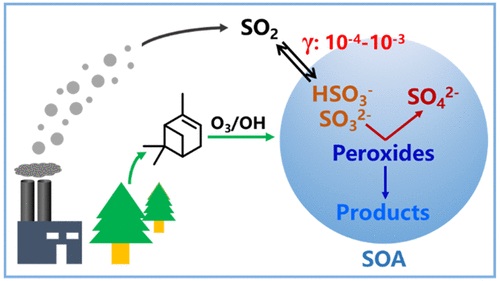当前位置:
X-MOL 学术
›
Environ. Sci. Technol. Lett.
›
论文详情
Our official English website, www.x-mol.net, welcomes your feedback! (Note: you will need to create a separate account there.)
Multiphase Reactions between Secondary Organic Aerosol and Sulfur Dioxide: Kinetics and Contributions to Sulfate Formation and Aerosol Aging
Environmental Science & Technology Letters ( IF 10.9 ) Pub Date : 2019-12-02 , DOI: 10.1021/acs.estlett.9b00657 Min Yao 1 , Yue Zhao 1, 2 , Minghao Hu 1 , Dandan Huang 3 , Yuchen Wang 4 , Jian Zhen Yu 4, 5 , Naiqiang Yan 1
Environmental Science & Technology Letters ( IF 10.9 ) Pub Date : 2019-12-02 , DOI: 10.1021/acs.estlett.9b00657 Min Yao 1 , Yue Zhao 1, 2 , Minghao Hu 1 , Dandan Huang 3 , Yuchen Wang 4 , Jian Zhen Yu 4, 5 , Naiqiang Yan 1
Affiliation

|
As two of the most important components of atmospheric fine particulate matter (PM2.5), secondary organic aerosol (SOA) and sulfate are tightly coupled in terms of their formation and evolution, yet our knowledge of the kinetics and mechanisms of such coupling remains incomplete. Here we show that the multiphase reaction between α-pinene-derived SOA and sulfur dioxide (SO2) results in efficient production of inorganic sulfate (85–90%) and organosulfates (10–15%) and chemical evolution of SOA. The reactive uptake coefficient of SO2 (γSO2) on α-pinene SOA was determined to be ∼10–4–10–3, depending markedly on the organic peroxide content (implicating an important role of particle-phase peroxides in SO2 oxidation) and also being strongly affected by the aerosol liquid water content. We estimate an aqueous-phase reaction rate constant (kII) of 154–1545 M s–1 for S(IV) with α-pinene-derived peroxides under weakly acidic conditions (pH ∼ 4–5). These kII values range between those for commercially available cumene hydroperoxide and 2-tert-butyl hydroperoxide and those for the smallest peroxides such as hydrogen peroxide and methylhydroperoxides. A quantitative analysis based on our estimated kII values indicates that the multiphase reaction between SOA and SO2 is an important pathway for sulfate formation and SOA aging that needs to be considered in the modeling of aerosol budgets and impacts on air quality and climate.
中文翻译:

次级有机气溶胶与二氧化硫之间的多相反应:动力学和对硫酸盐形成和气溶胶老化的贡献。
作为大气细颗粒物(PM 2.5)的两个最重要的组成部分,次生有机气溶胶(SOA)和硫酸盐在其形成和演化方面紧密耦合,但我们对这种耦合的动力学和机理的了解仍然不完整。在这里,我们表明,α-pine烯来源的SOA与二氧化硫(SO 2)之间的多相反应导致无机硫酸盐(85-90%)和有机硫酸盐(10-15%)的有效生产以及SOA的化学演化。确定α-pine烯SOA上SO 2(γSO 2)的反应吸收系数为〜10 –4 –10 –3明显取决于有机过氧化物的含量(暗示颗粒相过氧化物在SO 2氧化中的重要作用),并且还受到气溶胶液体水含量的强烈影响。我们估计在弱酸性条件下(pH〜4-5),S(IV)与α- pine烯衍生的过氧化物的水相反应速率常数(k II)为154-1545 M s -1。这些k II值在可商购获得的氢过氧化枯烯和2-叔丁基氢过氧化物的值与最小的过氧化物例如过氧化氢和甲基氢过氧化物的值之间。基于我们的估计k II的定量分析值表明,SOA和SO 2之间的多相反应是硫酸盐形成和SOA老化的重要途径,在气溶胶预算建模以及对空气质量和气候的影响中需要考虑这些途径。
更新日期:2019-12-03
中文翻译:

次级有机气溶胶与二氧化硫之间的多相反应:动力学和对硫酸盐形成和气溶胶老化的贡献。
作为大气细颗粒物(PM 2.5)的两个最重要的组成部分,次生有机气溶胶(SOA)和硫酸盐在其形成和演化方面紧密耦合,但我们对这种耦合的动力学和机理的了解仍然不完整。在这里,我们表明,α-pine烯来源的SOA与二氧化硫(SO 2)之间的多相反应导致无机硫酸盐(85-90%)和有机硫酸盐(10-15%)的有效生产以及SOA的化学演化。确定α-pine烯SOA上SO 2(γSO 2)的反应吸收系数为〜10 –4 –10 –3明显取决于有机过氧化物的含量(暗示颗粒相过氧化物在SO 2氧化中的重要作用),并且还受到气溶胶液体水含量的强烈影响。我们估计在弱酸性条件下(pH〜4-5),S(IV)与α- pine烯衍生的过氧化物的水相反应速率常数(k II)为154-1545 M s -1。这些k II值在可商购获得的氢过氧化枯烯和2-叔丁基氢过氧化物的值与最小的过氧化物例如过氧化氢和甲基氢过氧化物的值之间。基于我们的估计k II的定量分析值表明,SOA和SO 2之间的多相反应是硫酸盐形成和SOA老化的重要途径,在气溶胶预算建模以及对空气质量和气候的影响中需要考虑这些途径。



























 京公网安备 11010802027423号
京公网安备 11010802027423号